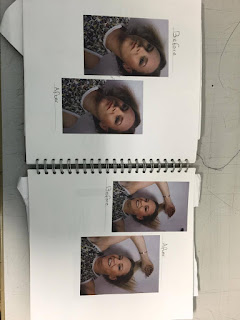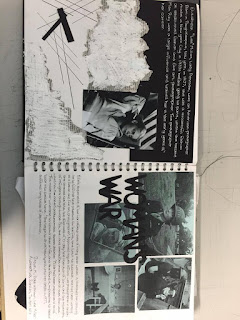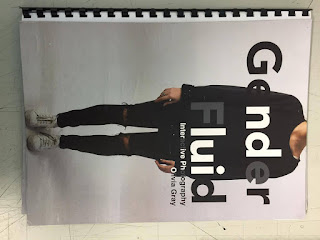For my final major project, I was given the theme
“structure” which I decided to base around Gender fluidity and the effect of
stereotyping in the fashion industry. I wanted to show visually through
photographs how both male and female are able to wear any type of clothing
without being stereotyped as either gender. It gave me a wide range of
different things to research such as, different ways people express their
sexuality, people’s opinions on things; being on cross-dressing, what clothes
they stereotype as either male or females and so much more. I also felt that I
needed to do something that was out or my way of thinking and more complex than
I’d usually choose also allowing me to show that I more than capable of
something out of my comfort zone. As this is my Final Major Project, I really
wanted to push myself to produce the finest piece of work yet and reach the
highest standard possible.
To pass the project, I must meet the standard of seven
different criteria. I have analysed the requirements and parameters of this by
creating a mind map stating what I needed to do to follow each criteria:
Context-I must look at gender fluidity and the effects society has on gender binary, and what impacts it has on both the public and society itself.
Research-I must have my own images of peoples clothing from the neck down, including peoples thoughts on what they think about nothing gender fluidity and what types of clothes they stereo type as both male and female but what I am doing is trying to get the public not to stereotype but to see everything as a equal.
Problem solving-For problem solving, I will annotate my sketchbook including any problems that i may come across.
Planning and production-I must set daily tasks for myself, such as for photo shoots and certain interviews i had with colleges. I had to plan a photo shoot with the lovely Stephanie Hirst and a very nice young man called Scotty.
Practical skills-lighting skills, understand manual settings and using them, arranging photoshoots, sketchbook work, photoshop work(resize, edit and retouch), book binding, spiral bound and creating a hard cover for it. English skills for when it came to writing information in my sketchbook.
Evaluation and
reflection- When completing work for my sketch book, I made sure to create a to-do list, so that i had the correct information and knew right away what i needed to do to improve complete my work.
Presentation-For the unit on presentation, I will be creating a 20 image presentation of my work, also known as Pecha Kucha and I will also be exhibiting my work at our end of year show.
Throughout my Final major project I have collected a range
of research such as primary, secondary and contextual. For my secondary research
I have done research on photographers such as; Elizabeth Lee Miller, who did a
photographic project on a women’s war, where women would take the places of men
at war. Trying to send the message that woman can do what men can do. Another
photographer being, Christer Stromholm one of my favourite photographers to
research, did a photography project in Paris in the 1960’s of transsexuals
called “ladies night”. I also did research on how to pose both men and women,
this being because I needed to know how to make people look masculine and
feminine. This gave me inspiration for my own shoot, where I took photographs
of a transgender model that had recently transitioned into being a woman,
Stephanie Hirst. Transgender women who was and still is a huge success in the
radio industry.
I have also collected a range of primary research. For this I have arranged my own photo shoots for instance my photo shoot for different types of clothing, which has helped me massively throughout the project as the images from the shoot are not my final images along with expressing that gender fluid is real and that others should not stereotype clothing. Another photo shoot that I was more that lucky enough to do was of "Stephanie Hirst", On 11 October 2014, Hirst announced during an interview with Stephen Nolan on BBC Radio 5Live that she was changing her name from Simon to Stephanie and was in the process of gender transitioning. In November 2014, and again November 2015 Stephanie was included in The Independent On Sunday 'Rainbow List' - an annual celebration of the 101 lesbian, bisexual, gay, and transgender people in the UK who make a real difference. This being the reason why I thought she would be a great opportunity for my project.
Throughout my FMP I had experienced a variety of problem's; I lost my memory stick which had all my original images on which meant I was limited to resources but thankfully my tutor had It on her desk all along. This problem taught me that I need to start looking after my work and paying close attention to where I keep my possessions, and to always back up my images immediately. Another problem I came across was the lack of communication with the reprographics team at this point when discussing my final major project they didn't tell me all the options available for my work and when i did discuss my final idea they didn't understand fully what i was talking about, which meant when it came to making the actual final product they couldn't do it. Due to this happening I came to the conclusion that I would have to change my design slightly. What was meant to be my final design became another test and maquette. This meant that I had to do my final design twice. Another problem being that my work was accidentally damaged by another student which meant that i had to reprint my final images and had damaged my maquette.
My time management in this project has been ok but could have been improved. For instance, I personally think i should have made more time for more photoshoots. I could have also made more time for primary and secondary research, so that my sketchbook was done to that highest standards. I gave myself plenty of time to produce my final flip book for any problems to occur which gave me time to handle any problems that would intervene.
I think my overall body of work was presented very well as I watched students interact with my maquettes and whilst watching I could tell my idea was something different to any other. I could over here discussions after they had been interacting and it got me thinking that I should include the public's opinions in my sketchbook. Overall I don't think I would changed anything to make improvements as i think it was just right.
My overall thoughts on the project is that I think I have had way too many problems throughout it which has knock both my confidence and enthusiasm for the project itself. But luckily, I have manage to complete and finish my sketchbook, maquettes and final pieces for the exhibition. I personally think also that I have achieved what I intended to and meet the criteria of my project proposal.







































 I also think this business card has the same qualities shown as the first business card. I love how obvious it is to know the type of business it is, and how the business card is an actual camera. I think it is a very creative way of advertising.
I also think this business card has the same qualities shown as the first business card. I love how obvious it is to know the type of business it is, and how the business card is an actual camera. I think it is a very creative way of advertising. 